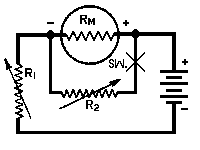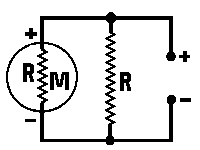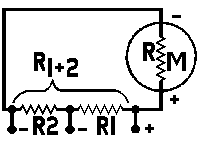| Meter Resistance | ||||
| The d-c resistance of a milliameter or | ||||
|
voltmeter movement may be determined as
follows: |
||||

|
||||
| 1. |
Connect the meter in series with a
suitable battery and variable resist- ance R1 as shown in the diagram above. |
|||
| 2. |
Vary R1 until a full scale reading is
obtained. |
|||
| 3. |
Connect another variable resistor R1
across the meter and vary its value until a half scale reading is obtained. |
|||
| 4. |
Disconnect R2 from the circuit and
measure its d-c resistance. |
|||
| The meter resistance RM is equal to the | ||||
| measured resistance of R2. | ||||
| Caution: Be sure that R1 has sufficient | ||||
|
resistance to prevent an off scale reading
of the meter. The correct value depends upon the sensitivity of meter, and voltage of the battery. The following formula can be used if the full scale current of the meter is known: |
||||
| R1 | = | voltage of the battery used | ||
|
|
||||
| full scale current of meter in amperes | ||||
|
For safe results, use twice the value com-
puted. Also, never attempt to measure the resistance of a meter with an ohmeter. To do so would in all proability result in a burned-out or severly damaged meter, since the current required for the operation of some ohmeters and bridges is far in excess of the full scale current required by the movement of the average meter you may be checking. |
||||
| Ohms per Volt Rating of a Voltmeter | |||||

|
|||||
| Where: |

|
= | ohms per volt, | ||
| Ifs | = | full scale current in amperes. | |||

|
|||||

|
|||||
| R | = | shunt value in ohms, | |||
| N | = | the new full scale reading divided | |||
|
by the original full scale reading,
both being stated in the same units, |
|||||
| RM | = | meter resistance in ohms | |||
| Multi-Range Shunts | |||||

|
|||||

|
|||||
| R1 | = | intermediate or tapped shunt value | |||
| in ohms, | |||||
| R1+2 | = | total resistance required for the low- | |||
| est scale reading wanted, | |||||
| RM | = | meter resistance in ohms, | |||
| N | = | the new full scale reading divided | |||
|
by the original full scale reading,
both being stated in the same units, |
|||||